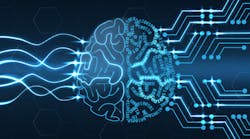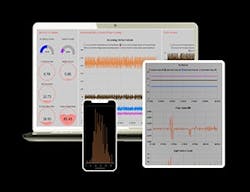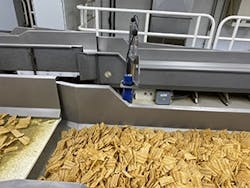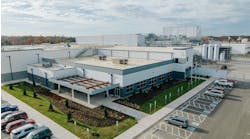There are a lot of uncertainties associated with manufacturing of all kinds, especially food and beverage products. Which of many possible factors are causing a process to fail? What constitutes a “good” product, and what should the threshold be before product must be reworked or discarded?
Answers to these questions can come from the processing equipment itself.
Artificial intelligence and machine learning are ways for the systems that run processing equipment to deal with gradations, subtleties and causations that are too complex or numerous for the human mind. AI is already being used in some food processing applications and has the potential to be used in many more, including maintenance, sanitation and logistics.
“AI and machine learning will impact most areas of manufacturing and supply chain in some manner,” says Richard Phillips, director of smart manufacturing at systems integrator Polytron, a member of the Control System Integrators Association. “We are already implementing solutions around schedule optimization, predictive maintenance and predictive analytics within food & beverage.”
AI, at its most basic, is a field in computer science that mimics human thinking, learning and memory. It can discover patterns and correlations that probably wouldn’t occur to human observers in applications where there are too many variables for the mind to handle.
“Any application where someone needs to review complex data, many times from multiple sources, and look for subtle correlations in the data may be a candidate,” Phillips says. “Due to the difficulty in processing all of this data, often times gut feel or tribal knowledge end up being the basis for decisions. This results in great variability and therefore lack of consistency in decision-making across the organization.”
Artificial intelligence can provide instant feedback on production and other trends, accessible by various devices. Photo: Key Technology
Making the grade
One of the most common applications for artificial intelligence is in sorting, grading and inspecting both ingredients and products. AI can help in two ways: by setting standards and specifications, and by helping to determine a cause if product suddenly starts to go far out of spec.
Key Technology, a supplier of sorting systems, starts most applications with a baseline “sort recipe” of what the product should look like, says Marco Azzaretti, director of marketing.
“However, the end result is always a sorter that is custom-programmed specifically for the unique processing line on which it is installed, because each installation has unique definitions of good in-spec product as well as the exact defects and the types of foreign materials and contaminants that must be eliminated,” Azzaretti says.
The Key system uses visual inspection in ordinary light. Other types of inspections also have the potential to benefit from AI. ImagoAI uses hyperspectral imaging with AI for inspection applications that ordinarily use detection methods like near infrared, to gauge components like fat and protein, to detect toxins and more.
“One of the principal benefits of imaging with AI is the ability to obtain higher accuracy and lower detection limits,” says Abhishek Goyal, CEO and co-founder of ImagoAI. “In general, the trend we see is companies are focusing on applications that are enabled by imaging AI to achieve lower detection limits or more complex physical relationships.”
Like near infrared, ImagoAI’s service requires 50 to 100 samples to set inspection standards; ImagoAI can process the images remotely and transmit the results back to the equipment. “In this way, our customers can benefit from AI modeling technologies without having to be experts in it,” Goyal says.
Prediction vs. prevention
One potential application of AI is predictive maintenance. It’s a step forward from preventive maintenance, which involves servicing or replacing equipment according to a predetermined schedule. Predictive maintenance is a program of continuously monitoring equipment and developing a profile of its performance that indicates when it’s likely to need attention.
Controllers, drives and other ancillary equipment often can be mined for data that AI can analyze to establish trends. Photo: Siemens
AI helps develop that profile through continuous assessment of parameters like temperature and vibration. Sensors attached to equipment such as motors and gearboxes continuously feed back their data, often to a cloud-based AI app, which analyzes it and develops a profile for when the equipment needs replacement.
A preventive maintenance program, however, isn’t straightforward or easy to implement. It requires specialized knowledge, especially for parameters like vibration, which is subject to many external variables. That’s why David McKenna, director of smart manufacturing solutions at Grantek Systems Integration Ltd., is dubious about its potential.
“My gut says, the things that break are so random and different and inconsistent that you can pack all the sensors you want, but finding patterns in that” is difficult, McKenna says. “I don’t think preventative maintenance is going to fix a lot of the downtime.”
Finding the causes
When it comes to fixing downtime or solving other problems like product going out of spec, AI has the capacity simply to consider more things – more potential causes – than the human mind is capable of. By noticing variations in inputs and other factors, AI can discover correlations that might go unnoticed by human observers.
Artificial intelligence has been used to develop product profiles that guide quality inspection. Photo: Siemens
“In any given production line - and even different products on the same line where relevant - there are different losses and inefficiencies: from waste due to overweight, quality rejects, size and shape variances, color inconsistencies, unstable yield, and so on,” says Liran Akavia, co-founder of Seebo, a provider of AI software. “And of course, the root causes of those losses also differ dramatically from production line to production line.”
A bakery in Europe recently used Seebo to help with a production-line problem: persistently underweight product. The software was able to isolate two parameters that consistently correlated with underweights: baking temperature above 400°F, and conveyor belt speed of less than 5 meters per second. Once those factors were adjusted, underweights dropped from 7.4% of production to 2.2%, for an annual saving of about $1 million.
To get to the root of the problem, Seebo had to consider many other factors than temperature and bake time, Akavia says.
“The Seebo solution conducts continuous, multivariate analysis on all the data relevant to the production process - from data on the raw materials, to quality data, and even external data like the weather, temperature or humidity; literally every piece of relevant data is being analyzed 24/7,” he says. “That also includes all the complex, dynamic interrelationships between the different data tags on the line.”
Cleaning the smart way
Artificial intelligence is also being looked at in more speculative applications. One of them is the subject of research at England’s Nottingham University, which is looking into the use of AI in equipment sanitation.
Clean-in-place (CIP) is an efficient and effective way to clean equipment, but it uses copious amounts of water. Nottingham researchers are developing a system that uses ultrasound and ultraviolet sensors to provide feedback that can serve to reduce water use.
“The ultrasonic sensors are attached to the outside of pipework and equipment, whereas the UV system is placed inside the top of a tank and feature UV lights and a camera,” says Nicholas Watson, an associate professor of chemical engineering at Nottingham University. “Both systems monitor fouling on a surface, and machine learning models are trained to determine once all of the fouling has been removed.”
The model, as it now stands, is intended to minimize water use, Watson says. “Other models could be developed to optimize parameters such as flow rates, temperature and chemical concentration to reduce time and resource use (linked to environmental sustainability), but this is the next stage of our work.”
Artificial intelligence and machine learning are some of the most powerful tools in computer science. Using them judiciously has the potential to increase efficiency in some of the most important, and challenging, applications to be found in a food plant.





